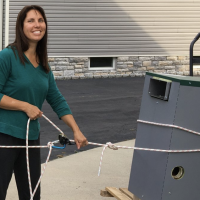leaking return line
Just bought a home with single pipe parallel steam heat system. We are learning as much as we can about it. Our issue : The return line is rusted an leaks in several places. We have been told we can replace the return line: or at least the leak with cpvc 1.5 inch pipe. Would that work? The insulated steam line runs around the basement to a vent. Then uninsulated pipe drops to the floor and returns 70 feet to the boiler. We can do the job ourselves if the cpvc would work . .
Comments
-
-
-
-
@spascuzzi where are you located? Besides for replacing the return, the boiler should have regular maintenance and attention. For the record, replacing the return, should be doable by anyone who knows how to handle pipe. Plumber, steam expert..... Just I would suggest not using the Plastic Man.
2 -
-
Use copper cpvc is good but it is garbage for that application. I am sure the 'Plastic Plumber" knows how to do copper but you would be better off with a steam guy.
0 -
All-Thank you for your comments on replacement of my return line with CPVC. A little background. I have experience in construction, electrical and a little in plumbing/heating. But no practical experience with steam. The local contractors are able to install any pipe I ask but do not seem to have a lot of experience with the type of steam I have. Most of their experience seems to be converting steam to hot water. I want to keep my steam so am trying to learn as much as I can.
The CPVC as well as black pipe have been suggested. Copper seems to be favored here. I can get a 10ft piece of copper for about $100. I would most likely to have to pay for install. I can get Flowguard Gold premium CPVC for $40 a 10ft piece-increments of 6. I can install it. Of course safety and function are the primary concern but cost is a reasonable consideration if there are viable options.
I noted the specific comment regarding shatter and some other specifics regarding the cons of using CPVC.
I sent the question to the mfg of Flowguard. I would very much appreciate if anyone has any other specific comments on the viability of CPVC for replacement of my return line. Clarifications of any pros or cons would be helpful. Thanks, Sam
0 -
Do you want to pay to do this twice? Repipe in copper or steel only. The person that suggested CPVC should know better. Mad Dog
4 -
A couple of general comments.
First, don't just replace the leaking section. Replace all the pipe which is in a similar setting at one go. Yes, the material cost will be greater — but the ultimate material cost will be the same, and the labour cost less. You'll only have to do the job once.
Second, there are two problems in my view with CPVC. The first is that it is possible, though I'll agree unlikely, that steam or very hot condensate might get into the pipe. The cpvc simply can't handle that temperature. The second is that a pipe down low, near the floor, is vulnerable to damage. Copper or iron won't break. CPVC might…
Br. Jamie, osb
Building superintendent/caretaker, 7200 sq. ft. historic house museum with dependencies in New England1 -
The CPVC does get weaker as it gets hotter as I read it…I'm known to try things, so I might try CPVC. There won't be water hammer in the wet return, and no steam will get down there.
But copper or steel is the right answer—if you want it to outlive you then go copper.
NJ Steam Homeowner.
Free NJ and remote steam advice: https://heatinghelp.com/find-a-contractor/detail/new-jersey-steam-help/
See my sight glass boiler videos: https://bit.ly/3sZW1el0 -
-
That's not always the case if you steam-clean your wet returns like I do with my gate valves on both ends & tees w/ boiler drains. Live Steam at 212 degrees or higher is gonna soften up most plastics CPVC, PVC, Pex. Don't even waste your precious time. Mad Dog
2 -
Thank you for your comments with a bit of explanation. Of course I want to get it right but cost is a consideration. As I said I am pretty new to steam heat. The house was built in 1823 to 1860, with the last section added in 1940. The steam heat fits in well and we like it. Some rationale helps with gaining a better overall understanding. Black pipe was also suggested. Any thoughts on that for a steam return or is copper the only option? The black pipe is about half the cost of copper and with a bit of help threading i could handle the install. Thanks for any comments and I think with this I've about exhausted my research. Thanks again. Sam
0 -
Black iron will rot out and need to be replaced again a lot faster than copper. Unless you scrub it with hot water and detergent before you install it black iron will get more oil in to the system which you will have to skim off the surface of the water in the boiler.
0 -
True… black pipe will rust out faster than copper will corrode, but unless there is some odd circumstance — such as loose weathered mortar falling on it — you should be able to get a century or so out of it.
Br. Jamie, osb
Building superintendent/caretaker, 7200 sq. ft. historic house museum with dependencies in New England3 -
Copper or black pipe. You've been told and it has been explained. If you want to use plastic, you might as well use garden hose. That will be cheap and last a few years too.
Black is cheaper than copper, but with the cost of fittings and labor will be more expensive. Black pipe will last 75 years; copper maybe 75 - 100.
Most residential customers care more about their counter tops than their heating system. A conscientious pre-purchase inspection might have netted a handsome credit for the leaky returns. If it was missed b y the "inspector," you may have some recourse.
Plastic pipe will fall apart quickly and get you or your plumber called a hack.
4 -
Copper fittings in the sizes you need are expensive but they are about the lowest cost fittings in that realm, black fittings are even more expensive. Many places where pex is suitable copper is less expensive because of the fitting cost even though the copper pipe is much more expensive than the plastic pipe.
0 -
One thing I will add is don't downsize the pipe to save money on the install, money is important double the money is even more important…
0 -
Thank you all for your help and taking the time to explain. Looks like copper for me. Sam
0 -
Plus CPVC or any Plastic will never meet any code. In most places inspectors will not approve plastic even for mundane things like the blow off pipe on relief, safety or T & P valves.
0 -
Hard drawn (rigid) copper pipe comes in four thicknesses: K, L, M and DWV, in order from heavy to light. You want L at least for steam wet returns.
—
Bburd0 -
Would certainly suggest copper over steel. Steel will "generate" it's own sludge, with will end up in the boiler.
0 -
For what it's worth, when I had a wet return which leaked like a sieve (really rather funny to look at)! I replaced it all with copper. Same nominal size, same elevation. No problem. That was about 30 years ago…
Br. Jamie, osb
Building superintendent/caretaker, 7200 sq. ft. historic house museum with dependencies in New England1 -
If you know the connected EDR of radiators, we could size the wet return pipe.
1 1/2" is for a fair sized system. Often see only 1 1/4" in houses.
0 -
No way that you need 1.5". 1" copper would probably be enough for most homes. But of course we need the numbers. And keep in mind, the old charts were sized assuming steel, which tends to rust on the inside and clog. There was a bit of a tendency to oversize to compensate for that. If you are looking to save on labor, you could always get yourself a ProPress. Maybe find a place that will rent it to you
2 -
-
sweating 1" is pretty easy and there usually isn't much flammable along the floor and the fittings are usually less expensive that propress. 1.25" isn't bad with just pipe and fittings but some components with 1.25" socket connections can have a lot of mass and be more challenging with hardware store grade torches.
0 -
-
And if the Bank Account is unlimited there is always Mega Press and Pro Press. But if it was my $$$$ 1" sweat copper will do most houses.
We had a High School with an addition that was fed with underground steam and condensate and the condensate line failed. I think the old condensate line was 2 1/2" or 3". We pulled a 1 1/2" rubber hose through it and it worked fine.
This school was being torn down and a new one built so the hose only had to get them through 1 winter.
1 -
The existing return runs tight against three outside walls. Would shortening the return at the corners to get the copper a few inches from those walls cause any issue. Doing so would amount to about 10 inches in 65 feet.
0 -
my friend Ed I think flushing a copper return is a once every 20 years thing. Have you seen how clean distilled water is?
NJ Steam Homeowner.
Free NJ and remote steam advice: https://heatinghelp.com/find-a-contractor/detail/new-jersey-steam-help/
See my sight glass boiler videos: https://bit.ly/3sZW1el0 -
You can generally run them any way you want, as long as you keep that at the same basic level relative to the boiler water level. What's important is ease of placing and connecting the fittings and protection from mechanical damage.
0 -
$100 a section seems high; what size are you using? 1” Type L is about $78.
0
Categories
- All Categories
- 87.3K THE MAIN WALL
- 3.2K A-C, Heat Pumps & Refrigeration
- 61 Biomass
- 429 Carbon Monoxide Awareness
- 120 Chimneys & Flues
- 2.1K Domestic Hot Water
- 5.8K Gas Heating
- 114 Geothermal
- 166 Indoor-Air Quality
- 3.7K Oil Heating
- 77 Pipe Deterioration
- 1K Plumbing
- 6.5K Radiant Heating
- 395 Solar
- 15.7K Strictly Steam
- 3.4K Thermostats and Controls
- 56 Water Quality
- 51 Industry Classes
- 50 Job Opportunities
- 18 Recall Announcements








